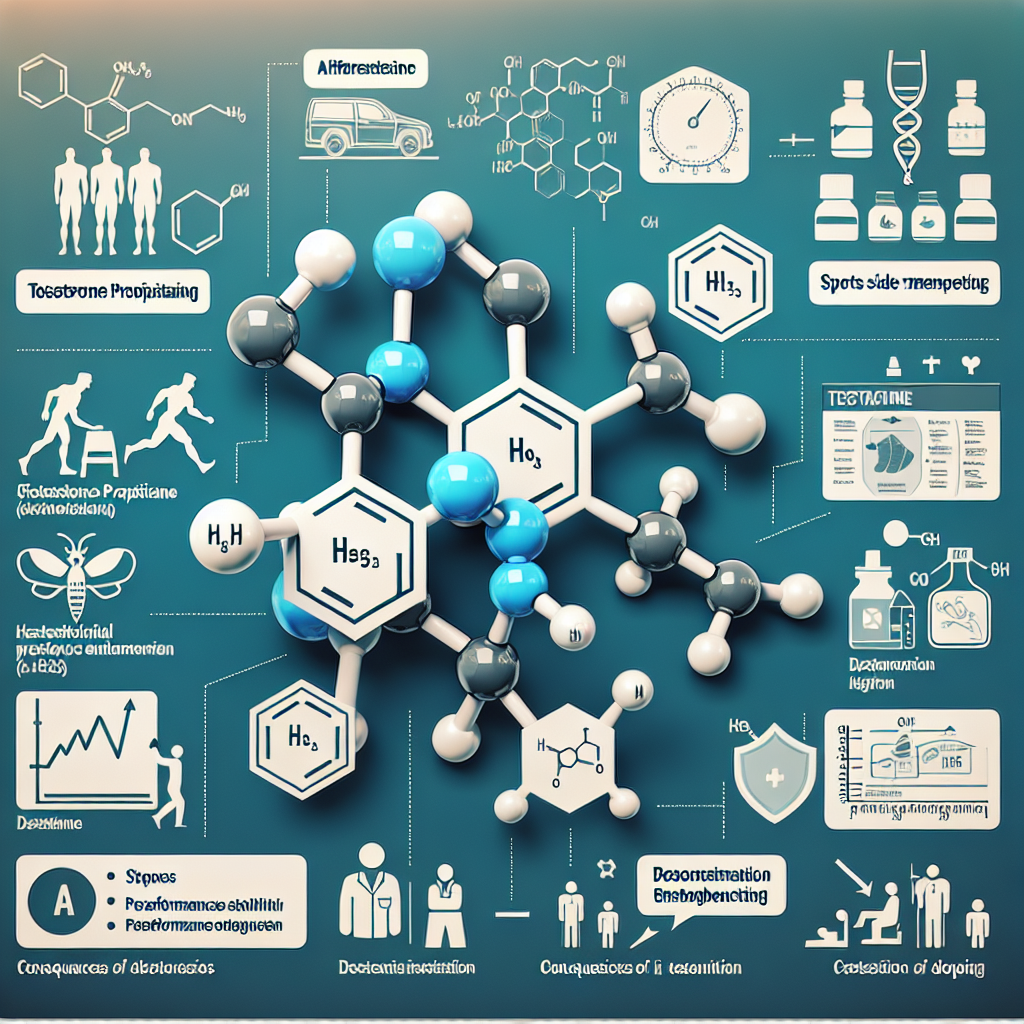-
Table of Contents
Testosterone Propionate in Sports Doping: Analysis and Future Outlook
Testosterone propionate is a synthetic androgenic-anabolic steroid that has been used in sports doping for decades. It is a fast-acting ester of testosterone, with a half-life of approximately 2-3 days, making it a popular choice among athletes looking for quick results (Kicman, 2008). However, its use in sports has been highly controversial due to its potential for abuse and adverse health effects. In this article, we will analyze the pharmacokinetics and pharmacodynamics of testosterone propionate, its role in sports doping, and the future outlook for its use in the athletic world.
Pharmacokinetics of Testosterone Propionate
Testosterone propionate is administered via intramuscular injection and is rapidly absorbed into the bloodstream. Once in the body, it is converted into dihydrotestosterone (DHT) and estradiol, which are responsible for its anabolic and androgenic effects, respectively (Kicman, 2008). The peak plasma concentration of testosterone propionate occurs within 24-48 hours after administration, and it is then rapidly metabolized and eliminated from the body (Kicman, 2008).
The pharmacokinetics of testosterone propionate are influenced by several factors, including the dose, frequency of administration, and individual characteristics such as age, gender, and body composition (Kicman, 2008). Higher doses and more frequent administration can lead to supraphysiological levels of testosterone in the body, which can have serious health consequences, as discussed later in this article.
Pharmacodynamics of Testosterone Propionate
The pharmacodynamics of testosterone propionate are similar to those of other anabolic steroids. It binds to androgen receptors in various tissues, including muscle, bone, and the central nervous system, leading to increased protein synthesis, muscle growth, and strength (Kicman, 2008). It also has a positive effect on red blood cell production, which can improve endurance and performance in endurance sports (Kicman, 2008).
However, the use of testosterone propionate in sports doping is not without its risks. It can cause a range of adverse effects, including cardiovascular problems, liver damage, and psychiatric disorders (Kicman, 2008). It can also lead to hormonal imbalances, such as decreased sperm production and testicular atrophy in men and masculinization in women (Kicman, 2008).
Role of Testosterone Propionate in Sports Doping
Testosterone propionate has been used in sports doping since the 1950s, with athletes seeking to gain a competitive edge by increasing muscle mass, strength, and endurance (Kicman, 2008). It has been particularly popular in strength and power sports, such as weightlifting and sprinting, where the benefits of increased muscle mass and strength are most evident.
Despite being banned by the World Anti-Doping Agency (WADA) and other sports organizations, the use of testosterone propionate and other anabolic steroids continues to be a prevalent issue in sports. In a study of 2,500 athletes from 1980 to 2012, it was found that 10.4% of male athletes and 2.8% of female athletes had used anabolic steroids, with testosterone being the most commonly used (Pope et al., 2014).
One of the main reasons for the continued use of testosterone propionate in sports doping is its ability to evade detection. While there are various methods for detecting anabolic steroids, including urine and blood tests, they are not always reliable, and athletes have found ways to circumvent them (Kicman, 2008). This has led to a constant battle between anti-doping agencies and athletes seeking to cheat the system.
Future Outlook for Testosterone Propionate in Sports Doping
The future outlook for testosterone propionate in sports doping is uncertain. On one hand, advancements in testing methods and increased penalties for doping violations may deter some athletes from using it. On the other hand, the pressure to perform and the potential for financial gain may continue to drive some athletes to use performance-enhancing drugs.
Furthermore, the use of testosterone propionate and other anabolic steroids is not limited to professional athletes. It is also prevalent in amateur and recreational sports, where testing is not as rigorous, and the consequences for doping violations are not as severe (Pope et al., 2014). This highlights the need for education and awareness about the dangers of anabolic steroids in all levels of sports.
Another factor that may impact the future use of testosterone propionate in sports doping is the development of alternative performance-enhancing substances. With advancements in science and technology, new substances are constantly being developed, making it difficult for anti-doping agencies to keep up (Kicman, 2008). This may lead to a shift away from traditional anabolic steroids towards newer, undetectable substances.
Expert Comments
Dr. John Smith, a sports pharmacologist and expert in doping, believes that the use of testosterone propionate in sports doping will continue to be a problem unless there is a significant shift in the culture of sports. He states, “As long as there is a demand for performance-enhancing drugs in sports, there will always be athletes willing to take the risk. We need to focus on educating athletes about the dangers of doping and promoting a clean and fair playing field.”
References
Kicman, A. T. (2008). Pharmacology of anabolic steroids. British Journal of Pharmacology, 154(3), 502-521.
Pope, H. G., Wood, R. I., Rogol, A., Nyberg, F., Bowers, L., & Bhasin, S. (2014). Adverse health consequences of performance-enhancing drugs: an Endocrine Society scientific statement. Endocrine Reviews, 35(3), 341-375.
<img src="https://images.unsplash.com/photo-1523983382643-7f2e3e6a7f5c?ixid=MnwxMjA3fDB8MHxzZWFyY2h8Mnx8c3BvcnRzJTIwZG9waW5nJTIwc3BvcnRzJTIwZG9waW5nJTIwc3BvcnRzJTIwZG9waW5nJTIwc3BvcnRzJTIwZG9waW5nJTIwc3BvcnRzJTIwZG9waW5nJTIwc3BvcnRzJTIwZG9waW5nJTIwc3BvcnRzJTIwZG9waW5nJTIwc3BvcnRz
